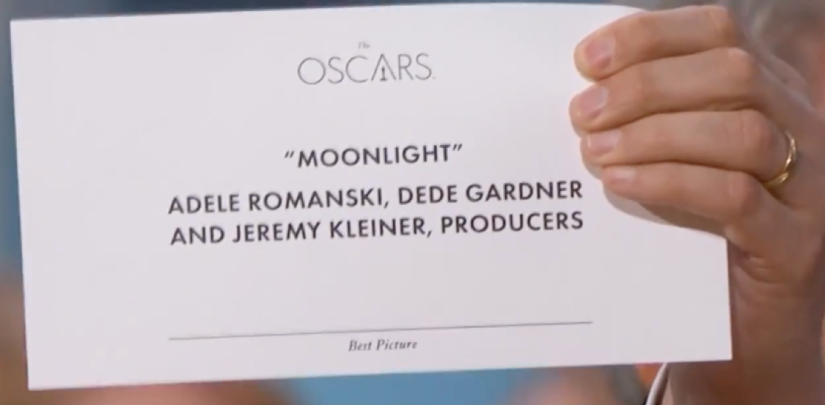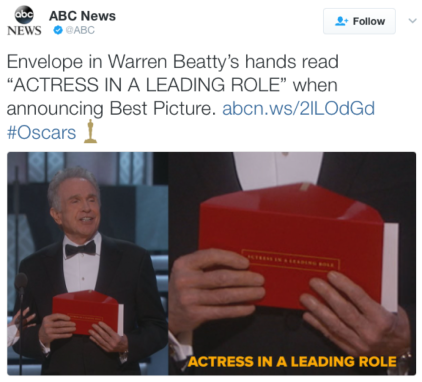I was one of the millions of people who watched the Oscars last Sunday. I was getting ready to turn off the TV when I noticed some disturbance behind the man talking, people fast walking behind the celebrating group and then a man with a headset walking across the stage with a red envelope, looking for the envelope and the card just used to read the winner for the most important category of the night. After that, there was chaos, confusion, and surprise as it was informed that there was a mistake and the wrong movie was announced as the winner. How that happened? It was the first time in the 89 years of the Academy Awards Ceremony.
Mr. Horowitz, a producer on that film spoke first and step aside to let speak Berger, another producer. It was at that moment when people with headsets walk across the stage. A man with a headset ask Horowitz to see the envelope he had on his hand and up to that point, he hasn’t read it. They open the envelope, and it says “Emma Stone, “La La Land.” That was the beginning of the end for La La Land as the winner for best picture.
After all the dust settles, in a backstage interview after the ceremony Emma Stone indicated that she was holding her “best actress card the whole time.” It turns out that this was part of the problem: there are two sets of envelopes for each category — so while Stone walked off with one card, Beatty was handed the other.
Why two envelops? For more than eighty years, PricewaterhouseCoopers has been in charge of the Oscars balloting process. The only two people who know the results are the two balloting leaders, who in James Bond style; memorize the winners so there’s no list that could leak out early. On Oscar night, each of them stations themselves on opposite sides of the stage throughout the ceremony and one of them hands the envelopes to the presenters, depending on which side of the stage the presenters enter from.
How we can improve this process? I will start by asking, do we really need two envelopes? I bet there is a rundown of for what side of the stage the presenters will enter from and based on that the balloting leaders would have to sort the envelopes between them. If this is too complicated or risky, then another solution could be the use of a second briefcase or a box to drop the envelopes of already announced categories.
Then it comes to what we know as Quality at the Source. I know, presenters are expecting to receive the right envelope, but we already see there are chances of mistake. They can read the outside of the envelope which is labeled with the name of the category and double-check that they received the right one.
 What about using visual management? We can see in these pictures that the font size for the category name on the envelope label and the card is not big enough. Considering that the card content is what the presenter will read in front of millions of people, I would increase the font size for the category, at least to the same size of the winner’s name. I would also move it to be on top of the winner’s name, so is the first thing the presenter will see. Maybe we can highlight to ensure they see it, after all, reading the category name will make no harm to the process. After the investigation that PwC is doing, the most important part is what will be done to avoid these from happening in the future. Hopefully, the root cause of the problem would be identified and after that, the process will be revised and improved.
What about using visual management? We can see in these pictures that the font size for the category name on the envelope label and the card is not big enough. Considering that the card content is what the presenter will read in front of millions of people, I would increase the font size for the category, at least to the same size of the winner’s name. I would also move it to be on top of the winner’s name, so is the first thing the presenter will see. Maybe we can highlight to ensure they see it, after all, reading the category name will make no harm to the process. After the investigation that PwC is doing, the most important part is what will be done to avoid these from happening in the future. Hopefully, the root cause of the problem would be identified and after that, the process will be revised and improved.
You must be logged in to post a comment.